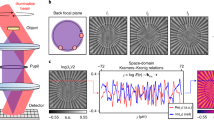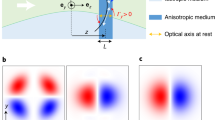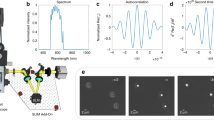Abstract
The dielectric tensor is a physical descriptor of fundamental light–matter interactions, characterizing anisotropic materials with principal refractive indices and optic axes. Despite its importance in scientific and industrial applications ranging from material science to soft matter physics, the direct measurement of the three-dimensional dielectric tensor has been limited by the vectorial and inhomogeneous nature of light scattering from anisotropic materials. Here, we present a dielectric tensor tomographic approach to directly measure dielectric tensors of anisotropic structures including the spatial variations of principal refractive indices and directors. The anisotropic structure is illuminated with a polarized plane wave with various angles and polarization states. Then, the scattered fields are holographically measured and converted into vectorial diffracted field components. Finally, by inversely solving a vectorial wave equation, the three-dimensional dielectric tensor is reconstructed. Using this approach, we demonstrate quantitative tomographic measurements of various nematic liquid-crystal structures and their fast three-dimensional non-equilibrium dynamics.
This is a preview of subscription content, access via your institution
Access options
Access Nature and 54 other Nature Portfolio journals
Get Nature+, our best-value online-access subscription
$29.99 / 30 days
cancel any time
Subscribe to this journal
Receive 12 print issues and online access
$259.00 per year
only $21.58 per issue
Buy this article
- Purchase on Springer Link
- Instant access to full article PDF
Prices may be subject to local taxes which are calculated during checkout





Similar content being viewed by others
Data availability
DTT datasets are available at https://drive.google.com/drive/folders/1r3X5rJPKskW8ceElz009v1CIgZFULZO3?usp=sharing. All other data supporting the findings of this study are available from the corresponding author on reasonable request.
Code availability
DTT source code and example data are available at https://github.com/BMOLKAIST/Dielectric-Tensor-Tomography.
References
Needleman, D. & Dogic, Z. Active matter at the interface between materials science and cell biology. Nat. Rev. Mater. 2, 17048 (2017).
Priestly, E. Introduction to Liquid Crystals (Springer Science & Business Media, 2012).
Inou, S. Collected Works of Shinya Inou: Microscopes, Living Cells, and Dynamic Molecules (World Scientific, 2008).
Tuchin, V. V. Tissue Optics (SPIE Press, 2015).
Woltman, S. J., Jay, G. D. & Crawford, G. P. Liquid-crystal materials find a new order in biomedical applications. Nat. Mater. 6, 929–938 (2007).
Erdmann, J. H., Žumer, S. & Doane, J. W. Configuration transition in a nematic liquid crystal confined to a small spherical cavity. Phys. Rev. Lett. 64, 1907–1910 (1990).
Lopez-Leon, T., Koning, V., Devaiah, K., Vitelli, V. & Fernandez-Nieves, A. Frustrated nematic order in spherical geometries. Nat. Phys. 7, 391–394 (2011).
Senyuk, B. et al. Topological colloids. Nature 493, 200–205 (2013).
Murphy, D. B. Fundamentals of Light Microscopy and Electronic Imaging (John Wiley & Sons, 2002).
Wang, Z., Millet, L. J., Gillette, M. U. & Popescu, G. Jones phase microscopy of transparent and anisotropic samples. Opt. Lett. 33, 1270–1272 (2008).
Kim, Y., Jeong, J., Jang, J., Kim, M. W. & Park, Y. Polarization holographic microscopy for extracting spatio-temporally resolved Jones matrix. Opt. Express 20, 9948–9955 (2012).
Jeong, J., Davidson, Z. S., Collings, P. J., Lubensky, T. C. & Yodh, A. Chiral symmetry breaking and surface faceting in chromonic liquid crystal droplets with giant elastic anisotropy. Proc. Natl Acad. Sci. USA 111, 1742–1747 (2014).
Tortora, L. & Lavrentovich, O. D. Chiral symmetry breaking by spatial confinement in tactoidal droplets of lyotropic chromonic liquid crystals. Proc. Natl Acad. Sci. USA 108, 5163–5168 (2011).
Smalyukh, I. I., Shiyanovskii, S. & Lavrentovich, O. Three-dimensional imaging of orientational order by fluorescence confocal polarizing microscopy. Chem. Phys. Lett. 336, 88–96 (2001).
Duclos, G. et al. Topological structure and dynamics of three-dimensional active nematics. Science 367, 1120–1124 (2020).
Rezakhaniha, R. et al. Experimental investigation of collagen waviness and orientation in the arterial adventitia using confocal laser scanning microscopy. Biomech. Model. Mechanobiol. 11, 461–473 (2012).
Kachynski, A., Kuzmin, A., Prasad, P. & Smalyukh, I. Coherent anti-Stokes Raman scattering polarized microscopy of three-dimensional director structures in liquid crystals. Appl. Phys. Lett. 91, 151905 (2007).
Lee, T., Trivedi, R. P. & Smalyukh, I. I. Multimodal nonlinear optical polarizing microscopy of long-range molecular order in liquid crystals. Opt. Lett. 35, 3447–3449 (2010).
Lee, T., Mundoor, H., Gann, D. G., Callahan, T. J. & Smalyukh, I. I. Imaging of director fields in liquid crystals using stimulated Raman scattering microscopy. Opt. Express 21, 12129–12134 (2013).
Wolf, E. Three-dimensional structure determination of semi-transparent objects from holographic data. Opt. Commun. 1, 153–156 (1969).
Park, Y., Depeursinge, C. & Popescu, G. Quantitative phase imaging in biomedicine. Nat. Photon. 12, 578–589 (2018).
Kim, K. et al. Optical diffraction tomography techniques for the study of cell pathophysiology. J. Biomed. Photonics Eng. 2, 020201 (2016).
van Rooij, J. & Kalkman, J. Polarization contrast optical diffraction tomography. Biomed. Opt. Express 11, 2109–2121 (2020).
Saba, A., Lim, J., Ayoub, A. B., Antoine, E. E. & Psaltis, D. Polarization-sensitive optical diffraction tomography. Optica 8, 402–408 (2021).
Born, M. & Wolf, E. Principles of Optics: Electromagnetic Theory of Propagation, Interference and Diffraction of Light (Elsevier, 2013).
Devaney, A. Inverse-scattering theory within the Rytov approximation. Opt. Lett. 6, 374–376 (1981).
Bracewell, R. N. & Bracewell, R. N. The Fourier Transform and Its Applications 31999 (McGraw-Hill, 1986).
Strang, G. Introduction to Linear Algebra (Wellesley-Cambridge Press, 1993).
Takeda, M., Ina, H. & Kobayashi, S. Fourier-transform method of fringe-pattern analysis for computer-based topography and interferometry. JOSA 72, 156–160 (1982).
Lauer, V. New approach to optical diffraction tomography yielding a vector equation of diffraction tomography and a novel tomographic microscope. J. Microsc. 205, 165–176 (2002).
Park, C., Shin, S. & Park, Y. Generalized quantification of three-dimensional resolution in optical diffraction tomography using the projection of maximal spatial bandwidths. JOSA A 35, 1891–1898 (2018).
Vennes, M., Zentel, R., Rössle, M., Stepputat, M. & Kolb, U. Smectic liquid‐crystalline colloids by miniemulsion techniques. Adv. Mater. 17, 2123–2127 (2005).
Lee, J.-H., Kamal, T., Roth, S. V., Zhang, P. & Park, S.-Y. Structures and alignment of anisotropic liquid crystal particles in a liquid crystal cell. RSC Adv. 4, 40617–40625 (2014).
Cairns, D. R., Sibulkin, M. & Crawford, G. P. Switching dynamics of suspended mesogenic polymer microspheres. Appl. Phys. Lett. 78, 2643–2645 (2001).
Basile, F., Bloisi, F., Vicari, L. & Simoni, F. Optical phase shift of polymer-dispersed liquid crystals. Phys. Rev. E 48, 432–438 (1993).
Francescangeli, O., Stanic, V., Lucchetti, L., Ferrero, C. & Burghammer, M. X-ray microdiffraction study of the liquid crystal ordering in confined geometries. Mol. Cryst. Liq. Cryst. 412, 59–67 (2004).
Nastishin, Y. A. et al. Optical characterization of the nematic lyotropic chromonic liquid crystals: light absorption, birefringence, and scalar order parameter. Phys. Rev. E 72, 041711 (2005).
Golovaty, D., Kim, Y.-K., Lavrentovich, O. D., Novack, M. & Sternberg, P. Phase transitions in nematics: textures with tactoids and disclinations. Math. Model. Nat. Phenom. 15, 8 (2020).
You, R., Choi, Y. S., Shin, M. J., Seo, M. K. & Yoon, D. K. Reconfigurable periodic liquid crystal defect array via modulation of electric field. Adv. Mater. Technol. 4, 1900454 (2019).
Doostmohammadi, A., Ignés-Mullol, J., Yeomans, J. M. & Sagués, F. Active nematics. Nat. Commun. 9, 3246 (2018).
DeCamp, S. J., Redner, G. S., Baskaran, A., Hagan, M. F. & Dogic, Z. Orientational order of motile defects in active nematics. Nat. Mater. 14, 1110–1115 (2015).
Laissue, P. P., Alghamdi, R. A., Tomancak, P., Reynaud, E. G. & Shroff, H. Assessing phototoxicity in live fluorescence imaging. Nat. Methods 14, 657–661 (2017).
Almohammadi, H., Bagnani, M. & Mezzenga, R. Flow-induced order–order transitions in amyloid fibril liquid crystalline tactoids. Nat. Commun. 11, 5416 (2020).
Park, S. M. et al. Fabrication of chiral M13 bacteriophage film by evaporation‐induced self‐assembly. Small 17, 2008097 (2021).
Cha, Y. J., Park, S. M., You, R., Kim, H. & Yoon, D. K. Microstructure arrays of DNA using topographic control. Nat. Commun. 10, 2512 (2019).
Gianaroli, L. et al. Birefringence characteristics in sperm heads allow for the selection of reacted spermatozoa for intracytoplasmic sperm injection. Fertil. Steril. 93, 807–813 (2010).
Wang, W., Meng, L., Hackett, R. & Keefe, D. Developmental ability of human oocytes with or without birefringent spindles imaged by Polscope before insemination. Hum. Reprod. 16, 1464–1468 (2001).
Madaschi, C. et al. Zona pellucida birefringence score and meiotic spindle visualization in relation to embryo development and ICSI outcomes. Reprod. Biomed. Online 18, 681–686 (2009).
Riching, K. M. et al. 3D collagen alignment limits protrusions to enhance breast cancer cell persistence. Biophys. J. 107, 2546–2558 (2014).
Shin, S., Kim, K., Yoon, J. & Park, Y. Active illumination using a digital micromirror device for quantitative phase imaging. Opt. Lett. 40, 5407–5410 (2015).
Lee, K., Kim, K., Kim, G., Shin, S. & Park, Y. Time-multiplexed structured illumination using a DMD for optical diffraction tomography. Opt. Lett. 42, 999–1002 (2017).
Kim, K., Kim, K. S., Park, H., Ye, J. C. & Park, Y. Real-time visualization of 3-D dynamic microscopic objects using optical diffraction tomography. Opt. Express 21, 32269–32278 (2013).
You, R. et al. Programmable liquid crystal defect arrays via electric field modulation for mechanically functional liquid crystal networks. ACS Appl. Mater. Interfaces 13, 36253–36261 (2021).
Acknowledgements
This work (S.S., H.H. and Y.P.) was supported by the Korea Advanced Institute of Science and Technology UP programme, BK21+ programme, Tomocube and National Research Foundation of Korea (2015R1A3A2066550) and by the Institute of Information & Communications Technology Planning & Evaluation grant funded by the Korean government (Ministry of Science and ICT; 2021-0-00745). S.S. and Y.P. acknowledge funding from the Korea Advanced Institute of Science and Technology Institute of Technology Value Creation, Industry Liaison Center (G-CORE Project) grant funded by the Ministry of Science and ICT (N11210014). J.E. and J.J. thank the National Research Foundation of Korea (NRF-2021R1A2C1011163) for support. This work (S.S.L.) was supported by the Korea Institute of Science and Technology Institution Program. C.L. and D.K.Y. thank the Ministry of Science and ICT (2021M3H4A3A01050378) for support. S.-H.K. acknowledges funding from the National Research Foundation of Korea (NRF-2020R1A2C2003245).
Author information
Authors and Affiliations
Contributions
Y.P. conceived the initial idea. S.S. developed the reconstruction algorithm, performed the experiments and simulations and analysed the data. J.E., S.S.L, C.L., D.K.Y., S.-H.K. and J.J. provided the samples and contributed analytic tools. H.H. contributed analytic tools. All authors wrote and revised the manuscript.
Corresponding author
Ethics declarations
Competing interests
The authors declare no competing interests.
Peer review
Peer review information
Nature Materials thanks Jeroen Kalkman, Oleg Lavrentovich and the other, anonymous, reviewer(s) for their contribution to the peer review of this work.
Additional information
Publisher’s note Springer Nature remains neutral with regard to jurisdictional claims in published maps and institutional affiliations.
Extended data
Extended Data Fig. 1 Experimental setup based on Mach-Zehnder interferometry equipped with a DMD.
PBS, polarizing beam splitter; M, mirror; DMD, digital micromirror device (DLi 4130, Digital Light Innovations Inc.); LCR, liquid-crystal retarder (LCC1223-A, Thorlabs Inc.); L1-L2, tube lenses (f = 300 mm); C, condenser (UPLSAPO 60XW, 60×, NA = 1.2, Olympus Inc.); O, objective lens (UPLSAPO, 60×, oil immersion, NA = 1.42, Olympus Inc.); BS, beam splitter; P1-P2, polarizer (LPVISE100-A, Thorlabs Inc.); Cam1-Cam2, image sensor (Lt425R, Lumenera Inc.); HWP, half-wave plate.
Extended Data Fig. 2 Experimental determination of the proper amount of slight tilt.
Isotropic RI tomograms of a 7-μm-diameter polystyrene microsphere immersed in oil (n = 1.565), reconstructed by (a) principles of the conventional ODT, (b) the slight tilt as 0.014 μm-1, and (c) the slight tilt as 0.042 μm-1 along the polar angle.
Extended Data Fig. 3 Illustration of the angular spectrum decomposition method for obtaining vector components of diffracted fields.
(a), The polarization state of an oblique plane wave passing through a polarizer \(\overrightarrow {p_\alpha }\) is determined by the incident wave vector \(\overrightarrow {k_i}\) and the direction of the polarizer \(\overrightarrow \alpha\). (b), Under a right circularly polarized plane wave illumination, a diffracted field from a sample is polarization sensitively measured using two different directions of a polarizer, α1 = −45° and α2 = 45°, respectively (top). The measured fields are decomposed into the multiple plane waves (bottom). (c), Each decomposed plane wave is vectorized (top), and inverse Fourier transform of the multiple vectorized plane waves gives the vectorial diffracted field (bottom). In the color circle at the right side, the symbols A and φ denote the normalized amplitude and phase of the fields in the image plane, respectively. For visualization purposes, the symbols A and φ denote the normalized logarithmic amplitude and phase of the fields in Fourier plane, respectively.
Extended Data Fig. 4 Validation of DTT by numerical simulations.
The DTT results for simulated anisotropic microspheres. (a and c) Cross-sectional slices of the reconstructed 3D dielectric tensor of the anisotropic microspheres in the x–y, y–z, and z–x planes. (b and d) Cross-sectional slices of the principal refractive indices no, ne overlaid with the directors \(\hat n\), and a 3D view of the directors \(\hat n\) with the isosurfaces from no as 1.547. The white and black dashed lines indicate the cross-section positions.
Extended Data Fig. 5 Comparison of 3D directors of the LCN film.
(a, c) Reconstructed directors in the LCN film by DTT, and (b, d) estimated directors in the LCN film by commercial simulation software (TechWiz LCD 3D). (e) A recorded PLM image of the LCN film shown in (a, c). (f) A simulated PLM image from the estimated directors in (b, d). As in the case of LCN film comprising mixed and photopolymerized materials, our approach serves an invaluable tool for characterizing anisotropic materials whose properties are inaccessible. Unlike LC simulations demanding accurate material properties, DTT is based on experimental measurements and does not require any material properties for the reconstruction, such as the principal RIs, elastic constants, or morphological information.
Supplementary information
Supplementary Information
Supplementary Discussion Sections 1–3 and Figs. 1 and 2.
Supplementary Video 1
LC particle with radial configuration. The 3D rendered view of the directors with the isosurfaces from no as 1.547. The radial configuration and the radial hedgehog are shown for various perspectives.
Supplementary Video 2
LC particle with bipolar configuration. The 3D rendered view of the directors with the isosurfaces from no as 1.547. Various perspectives reveal the characteristic orientational alignments of bipolar configurations including the surface topological defects, boojums.
Supplementary Video 3
LCLC droplet in equilibrium. The lemon-shaped morphology and twisted bipolar orientational configuration of a stable LCLC droplet are clearly shown in the 3D rendered view for various perspectives.
Supplementary Video 4
Annihilation of an LCLC droplet. Incoming thermal energy breaks the equilibrium of the nematic–isotropic coexistence phase. Time-lapse 3D views for perspective views visualize the shrinking area, height and volume of the nematic tactoid.
Supplementary Video 5
Nucleation of a LCLC droplet. Time-lapse 3D views of the nucleation and growing of a LCLC droplet. For various perspectives, increasing non-equilibrium orientational defects can be found during the growth of the droplet.
Supplementary Video 6
Merging LCLC droplets. By cooling, neighbouring LCLC droplets are growing and merging into a single droplet. Relaxation to the lemon shape at equilibrium is verified for various perspectives.
Rights and permissions
About this article
Cite this article
Shin, S., Eun, J., Lee, S.S. et al. Tomographic measurement of dielectric tensors at optical frequency. Nat. Mater. 21, 317–324 (2022). https://doi.org/10.1038/s41563-022-01202-8
Received:
Accepted:
Published:
Issue Date:
DOI: https://doi.org/10.1038/s41563-022-01202-8
This article is cited by
-
High-resolution assessment of multidimensional cellular mechanics using label-free refractive-index traction force microscopy
Communications Biology (2024)
-
Coherent optical two-photon resonance tomographic imaging in three dimensions
Communications Physics (2023)
-
Neural networks determination of material elastic constants and structures in nematic complex fluids
Scientific Reports (2023)
-
Polarization-sensitive intensity diffraction tomography
Light: Science & Applications (2023)
-
Volume imaging of anisotropic materials
Nature Materials (2022)



